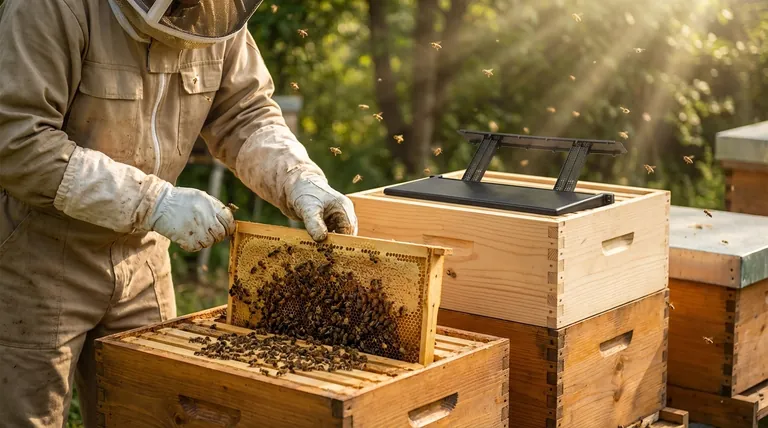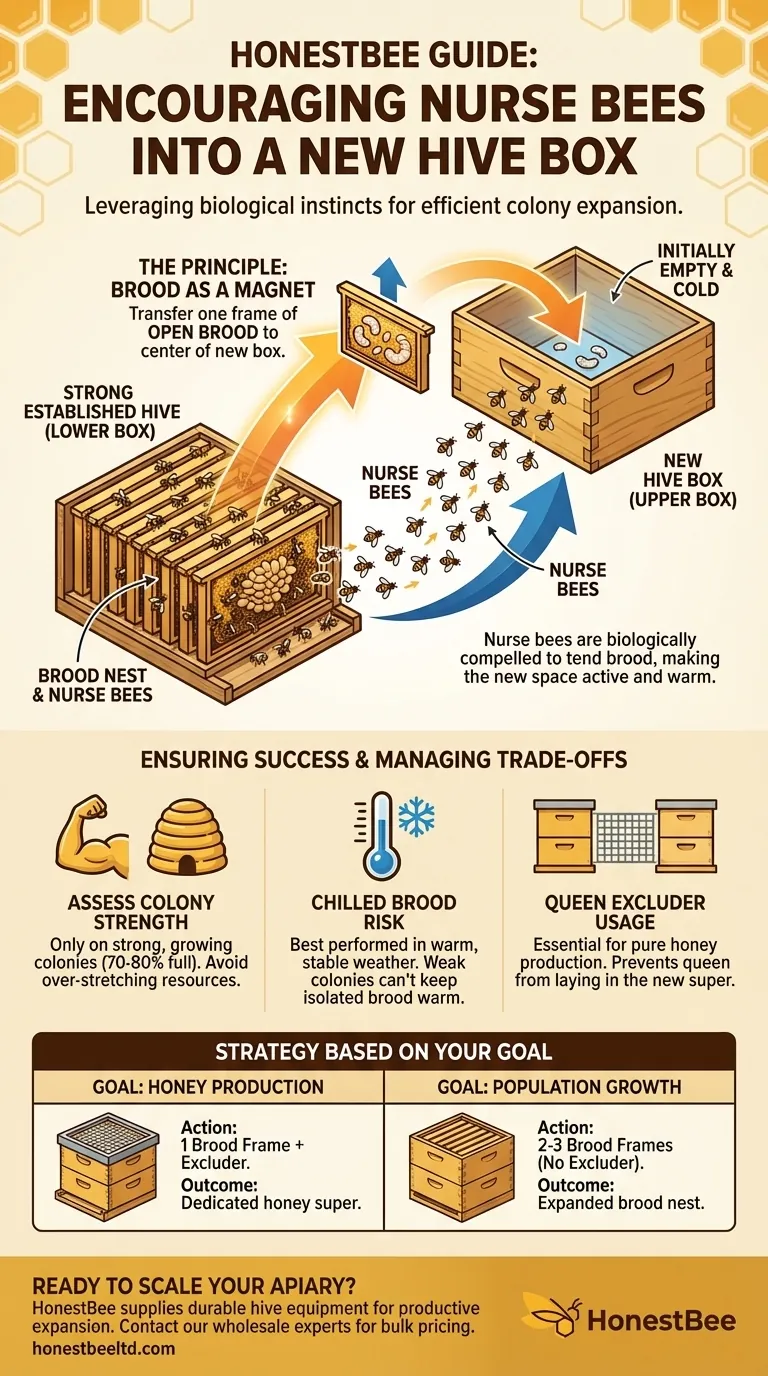To encourage nurse bees to move into a new hive box, the most direct and reliable method is to transfer a frame containing brood from an established box into the center of the new one. Nurse bees are biologically compelled to tend to the eggs and larvae, so they will immediately follow the brood frame into the new space. This simple action signals to the rest of the colony that the new box is an active and essential part of the hive.
A honeybee colony expands based on biological imperatives, not empty space. Instead of waiting for bees to move up on their own, you must provide a compelling reason. Leveraging their instinct to care for brood is the most reliable way to guide a colony's expansion.

The Principle: Brood as a Bee Magnet
Why Bees Hesitate to Move Up
A healthy bee colony is incredibly efficient. The bees maintain a core area, the brood nest, at a precise temperature and humidity. An empty, new box is seen as cold, undefended, and resource-intensive territory that they will not occupy without a strong incentive.
The Role of the Nurse Bee
Young worker bees, known as nurse bees, have one primary function: to feed and care for the queen's offspring (the brood). Their entire world revolves around the location of eggs and larvae. They will not abandon the brood, making them the key to encouraging movement.
How to "Bait" the New Box
The technique is to move one frame of open brood—meaning a frame with visible eggs and young larvae—from a crowded lower box into the center of the new, upper box. The presence of this brood acts as an irresistible magnet, drawing thousands of nurse bees upward to care for it. The warmth and activity they generate make the new box a viable and attractive space for the rest of the colony.
Ensuring the Expansion is Successful
From Nurses to Nectar
Once nurse bees have established a presence in the new box, it signals to foraging bees that the area is safe and active. This encourages the foragers to begin storing nectar in the adjacent empty frames, effectively kick-starting the use of the new super for honey production.
Assess Colony Strength First
This technique should only be used on a strong, growing colony. Before adding a new box, inspect the one below it. If the bees have drawn out and are using at least 70-80% of the frames, they are ready for expansion. Adding space too early can stretch the colony's resources too thin.
Using a Queen Excluder
If your goal is to create a super for pure honey collection, you must place a queen excluder between the old box and the new one. The excluder's grid is large enough for worker bees to pass through but too small for the queen. This prevents her from following the nurse bees up and laying more eggs in your honey super.
Understanding the Trade-offs
The Risk of Chilled Brood
Moving a single frame of brood away from the warm cluster is not without risk, especially in cooler weather. If the colony isn't strong enough, they may not be able to send enough bees upward to keep the isolated brood warm, which can cause it to die. This technique is best performed during warm, stable weather.
The Unintended Brood Chamber
If you "bait" a new super with brood but do not use a queen excluder, the queen will often move up and continue laying eggs. This turns your intended honey super into another brood chamber. This is desirable if your goal is population growth, but it thwarts honey-only production in that box.
Disrupting the Brood Nest's Integrity
You are temporarily splitting the colony's nursery. While highly effective, this management technique is a form of disruption. It should be done purposefully and only on hives that are strong enough to easily manage the split focus.
Making the Right Choice for Your Goal
Your strategy for baiting a new box depends entirely on your objective for that space.
- If your primary focus is honey production: Use one frame of open brood to draw bees up, but place a queen excluder underneath the new super to ensure it becomes a dedicated space for honey once that first frame of brood hatches.
- If your primary focus is expanding the brood nest: Move two or three frames of brood into the new box without a queen excluder to give the queen ample space to lay and rapidly grow the colony's population.
By understanding and leveraging the bees' natural instincts, you can guide your colony's growth with precision and purpose.
Summary Table:
| Action | Purpose | Key Consideration |
|---|---|---|
| Transfer a frame of open brood | Acts as a biological magnet for nurse bees. | Use only on strong, healthy colonies. |
| Place frame in center of new box | Signals the new space is an active part of the hive. | Best performed in warm, stable weather. |
| Use a queen excluder | For honey production; prevents queen from laying in the super. | Not needed if goal is population growth. |
Ready to expand your apiary with confidence?
As a commercial beekeeper or distributor, efficient colony management is key to your success. HONESTBEE supplies the durable, high-quality hive boxes and equipment—including reliable queen excluders—that strong colonies need for productive expansion.
Let us help you scale your operations. Contact our wholesale experts today to discuss your beekeeping supply needs and get bulk pricing.
Visual Guide

Related Products
- 3.5L Plastic Beehive Frame Feeder Deep Frame Water Feeder for In Hive Use
- Professional In-Hive Frame Bee Feeder by HONESTBEE
- In-Hive Dual Compartment Frame Bee Feeder for Targeted Colony Nutrition
- Professional In-Hive Bee Feeder HONESTBEE Frame for Beekeeping
- Assembled Wooden Bee Frames with Beeswax Foundation Ready to Use by HONESTBEE
People Also Ask
- What are the two most popular types of honey bee feeders? A Guide to Frame and Bucket Feeders
- What is a frame feeder? A High-Capacity, Secure In-Hive Feeding Solution
- What are the advantages of frame feeders? Ensure Safe, In-Hive Feeding for Your Colony
- How do I keep bees from drowning in my frame feeder? Essential Tips for a Safe Hive
- What are the advantages of using a frame feeder? Boost Hive Health with In-Hive Feeding



















